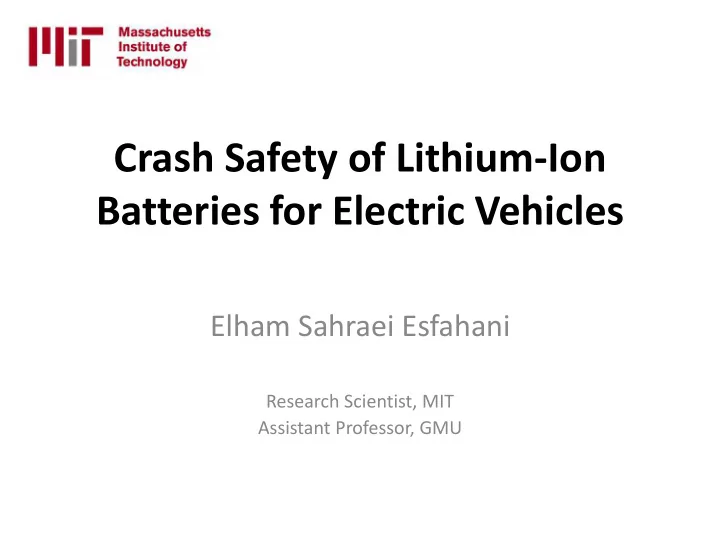

Crash Safety of Lithium-Ion Batteries for Electric Vehicles Elham Sahraei Esfahani Research Scientist, MIT Assistant Professor, GMU
Vehicle Crashes and Testing
Battery Packs in T Configuration Fisker Karma Chevy Volt
Battery Packs under the Floor BMW i3 Concept Tesla model S Mitsubishi i-MiEV
EV, PHEV Battery Packs LG Chem, Compact Power, Inc A123 Systems L5 Hymotion
Inside Structure of Lithium-ion Cells 1. Anode coating, often graphite 2. Anode current collector, Copper 3. Separator, polymeric or ceramic 4. Cathode coating, Lithium metal oxide 5. Cathode current collector, Aluminum Scanning Electron Microscope (SEM) Courtesy of Exponent Nail Intrusion Test
Short Circuiting of Batteries Chevy Volt, after Crash Test at NHTSA
Real World Accidents Downloaded from Internet
Problem: Internal Short of Batteries During Vehicle Crash • How much deformation/force a cell can tolerate before reaching internal short circuit? • Vehicle crashes are inevitable. Often battery packs are also damaged in case of a crash! • How to design batteries, packs, and vehicle structure to minimize risk of thermal runaway in case of a crash? • Experimental method? • Computational tools? Picture from: http://www.columbiamissouricaraccidentlawyer.com/
Finite Element Modeling as a Tool for Design and Optimization • Finite element model of batteries for: – Identify best electrode/separator components – Choice of cell shell casing (material & geometry) – Choice of center core (material & geometry) – Design of BIW, pack housing and connections
Summary of Cell Level Testing Characterization of Mechanical Properties JPS, Sahraei et al, 2014 JPS, Sahraei et al, 2012
Spherical Tests: Load vs. Time
Constitutive Properties of Jellyroll From test of compression between two flat plates Using Principal of Virtual Work Small and Large cells Medium cell JPS, Sahraei et al, 2014
Detecting Short Circuit in Tests JPS, Sahraei et al, 2012 Medium Pouch Cell Measuring load, displacement, voltage, and temperature JPS, Sahraei et al, 2014 at the same time, short circuit is characterized by: • Drop in force • Drop in voltage • Rise in temperature
Characterization of Elliptical Cell 𝑤 𝑄𝜀𝑥 = ම 𝜏 𝑦 𝜀𝜗 𝑦 + 𝜏 𝑧 𝜀𝜗 𝑧 + ⋯ + 𝜐 𝑧𝑨 𝜀𝛿 𝑧𝑨 𝑒𝑤 0 Assumptions: • Expansion in Y direction leads to delamination ( 𝜏 𝑧 =0) • Due to porosity and low Poisson ratio 𝜗 𝑦 ~ 0 𝑐 0 • No binder between layers, free to slide, 𝜐 𝑧𝑨 ~ 0 𝑐 𝑥 𝑤 𝑄𝜀𝑥 = ම 𝜏 𝑨 𝜀𝜗 𝑨 𝑒𝑤 0 Z 𝑄(𝑥) = ඵ 𝜏 𝑨 (𝑥) 𝑒𝐵(𝑥) Considering uniform strain in flat section: 𝐵 𝑥 = 𝑐 𝑥 𝑀 Y 𝑄 𝜗 𝜗 𝑨 = 𝑥 𝜏 𝑨 𝜗 = 𝑐 𝑥 = b 0 + πw (b 0 + πw Inextensibility of shell casing: 4 )𝑀 X 2𝑆 4 𝜏 𝑨 𝜗 = 𝑏 2𝑠𝜗 𝑨 − ℎ 𝑜 + 𝑛 𝑄 𝑥 = 𝑏 𝑥 − ℎ 𝑜 + 𝑛 (b 0 + π2𝑠𝜗 𝑨 𝑏 = 1100, ℎ = 1.4, 𝑜 = 3, 𝑛 = 4660𝑂 )𝑀 4
Solving micro equilibrium & calculating macro stresses 𝐸1 𝑌 𝐸1 𝑌 𝑔 𝑔 1 𝜏 𝑦𝑦 𝜏 𝑦𝑧 𝑧 𝑦 𝐐 𝐍 = 𝜏 𝑧𝑧 = 𝐸2 𝑍 𝐸2 𝑍 𝜏 𝑧𝑦 𝑊 𝑔 𝑔 𝑦 𝑧
Failure criterion at various loading scenarios Failure criterion programed in RADIOSS (SAHRAEI1)
Finite Element Models • A model of cell is developed by discretizing geometry into small elements • Boundary conditions are applied • Loading conditions are applied • Material propertied are defined • A software (here: LS Dyna) used to solve partial differential equations of the boundary value problem • Here for the Battery Model, two parts are defined: – Solid element for jellyrolls – Shell element for cell casing
Development of macro model Mat 63, isotropic crushable foam model with erosion option Three important inputs: • Compressive stress-strain relationship • Tensile cut-off value • Principal strain to failure Compressive stress- Tensile cut-off value : 25 MPa Principal strain to failure: a function of loading condition strain
Simulation Scenarios • Compression between two flat plates • Rigid rod indentation
Comparison of Test and Simulation/ Flat Compression
Validation of Model against Punch Indentation
Hemispherical Punch Indentation
Computational Model of Cylindrical Cell CT Scans courtesy of Exponent
Uniaxial Tension Testing Procedure Specimens are Cut Using Templates and Various Specimens Shown Post-Testing an X-Acto Knife 4 TH MIT WORKSHOP ON SAFETY OF LITHIUM ION BATTERIES 10/31/2013
Uniaxial Tension Testing Procedure Instron Test Machine Model 5499 Specimen Ready for Testing 4 TH MIT WORKSHOP ON SAFETY OF LITHIUM ION BATTERIES 10/31/2013
Uniaxial Multilayer Tension Tests 4 TH MIT WORKSHOP ON SAFETY OF LITHIUM ION BATTERIES 10/31/2013
Pure Compression Simulation
Uniaxial Loading Scenarios
Failure Mechanism in uniaxial Compression/Tension
Combined Compression/Tension 2Compression=Tension Sequence of failure : 1- Aluminum, 2-Copper/Separator, 3-Separator/copper
Fracture Strain a Function of Loading 0.35 0.3 0.25 Failure Strain 0.2 0.15 0.1 0.05 0 0 5 10 15 20 Ratio of Compressive Strain to Tensile Strain
Pack Protection Structures Studied by Juner Zhu et al
Simulation of Ground Impact Studied by Juner Zhu et al
Shield Plate Design Studied by Juner Zhu et al
Summary • Battery crash response is an important part of battery design for an electric vehicle • An experimental program using a combination of compression and tensile loading on battery cells and its layered components can be used to characterize material properties of the cell • Finite element modeling is an effective tool to predict deformation of a battery cell under crash loading • Finite element modeling is used to predict effect of strength of each layer on average properties of a cell • Effective design of protective plate can reduce damage to battery cells
Recommend
More recommend